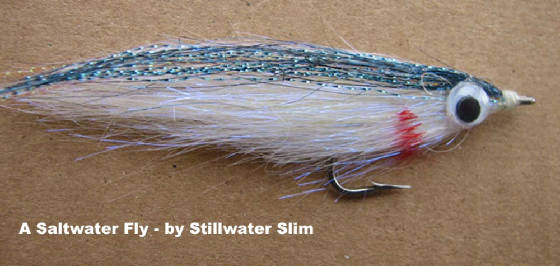Welcome to River Magic
Stillwater Slim on the Line ... January 14, 2009
|
|
Yet More Winter Projects – Learning to Tie Flies
Winter is the ideal time to learn how to tie flies. Fly tying courses are held at this time of year and there is help available from books, videos and the Internet. Flies are usually tied for fishing, but they can also be made as art objects or accessories.
Fishing flies for Guysborough County can be categorized as trout, salmon and saltwater:
Trout Flies:
Trout flies usually imitate organisms that trout feed upon, and a trout’s menu is quite extensive. A good selection of dry flies, emergers, wet flies, nymphs, streamers, freshwater shrimp, terrestrials, worms and leeches will cover most of the trout food imitations. At times trout prefer attractor flies – flies that don’t imitate anything in particular but appear lifelike to curious or aggressive trout.
Salmon Flies:
Salmon flies are attractor flies that arouse a salmon’s curiosity, playfulness, or aggression. They can be dry flies like the MacIntosh, Bomber and Wulff patterns, and wet flies, streamers, terrestrials, nymphs, and shrimp. A range of fly sizes is needed for varying conditions. Although we don’t really understand why salmon take flies, many patterns have consistently proven their effectiveness. Their most important quality seems to be that they appear lifelike when fished.
Saltwater Flies:
Saltwater flies catch saltwater species and fish like sea-run trout that spend a portion of their lives in saltwater. Usually tied on stainless steel rustproof hooks, they imitate baitfish and shrimps that sport fish feed upon in their saltwater habitat. Often our flies must compete for attention with huge schools of baitfish, so an injured minnow or attractor-type fly can also be effective, like a new delicacy waiting for a taste test. Striped bass usually require baitfish imitations fished on a sinking line, but there are times, when stripers are feeding near the surface, that they will aggressively take noisy bass popper flies that create a disturbance.
Artistic flies include classic salmon flies and super-realistic flies. We also tie accessory flies as hatpins, lapel pins, or earrings.
This overview shows that fly tying, like fly fishing, offers plenty to keep the hobby interesting. New materials, mostly synthetic, are continuously being developed for the hobby, making it possible for the tyer to create better flies.
If the hobby interests you, you might want to give it a try. Trying it is easy – starting January 10/2009, a free fly tying workshop is held each Saturday afternoon from 1 – 4 pm at the River Magic Fly Shop in Stillwater. Bring along fly tying tools if you have them. Hooks, instruction and materials are provided free!
Please stay on the line … |
